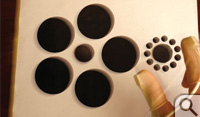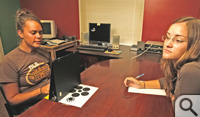Changing your spots
Optical illusions can be deceiving, but are we just fooling ourselves?
Optical illusions are everywhere. You see them in the comics sections in newspapers and in little books full of odd facts and trivia. The caption is usually a question: Which of the two lines is longer? Do you see faces…or a vase? Do you see a young woman or an old hag?
One of the most common optical illusions is also one of the most useful to scientists studying the brain. “It’s called the Ebbinghaus illusion or the Titchener circle illusion,” Peter Vishton explained. “It’s been studied for more than 100 years.”
You probably know the Ebbinghaus illusion from its caption asking which of the two center circles looks larger. Vishton, assistant professor of psychology at William and Mary, believes he saw his first Ebbinghaus illusion on the back of a cereal box. He now leads a group of psychologists conducting experiments using a slightly more sophisticated version of the Ebbinghaus illusion to explore how the human visual system processes information. Vishton demonstrated his group’s methodology one fall day in his lab in Bell Hall, showing a visitor two black disks.
The illusion begins
"Here are two disks that are approximately the same size. We put them on
a piece of paper and people will be about fifty-fifty as to which one
they pick  as the bigger. We expect that,” he explains. Then he takes
out a third disk, noticeably larger than the first two. “If we put one
that’s a little bit bigger on one side, people pick the one that’s
bigger almost 100 percent of the time. Nothing interesting there.”
as the bigger. We expect that,” he explains. Then he takes
out a third disk, noticeably larger than the first two. “If we put one
that’s a little bit bigger on one side, people pick the one that’s
bigger almost 100 percent of the time. Nothing interesting there.”
The interesting part comes when the two circles are inserted in an Ebbinghaus array. “One is surrounded by big circles and one is surrounded by smaller circles,” Vishton said. He plucks the disk from the center of a ring of smaller circles and holds it up. “Now most people say this one looks bigger than the one surrounded by the big circles.”
It gets even more interesting. If the Ebbinghaus illusion “fools your mind,” as the cereal boxes usually have it, then the deception is far from complete. In a paper published recently in the journal Psychological Science, Vishton and a group of colleagues presented evidence that when subjects reach—or even plan to reach—for a target disk, the effect of the illusion decreases.
Reaching for an answer
"The way that this has worked for most of the 100 years that the illusion has been studied is a task much like what we just discussed. I say look at this display and you make a conscious decision about which one looks bigger,” he said. “More recently we and other people have been using techniques in which we don’t ask people to make an overt explicit judgment about them but we ask them to engage in a visual motor-action task.”
To monitor the motor-action task, subjects were fitted with position sensors—a wired glove on their thumb and forefinger—and asked to pick up the disk that appears larger. The position sensors allow researchers to monitor the subjects’ grip aperture, the distance between thumb and forefinger, as they reach for the target disk.
“You start with their fingers close together. Then you move them
apart until they’re quite a bit bigger than the target you’re reaching
for. That  happens about 65 percent of the way through the reach. And
then you close them down until at the end of the reach it matches the
size of the target,” Vishton explains. “When we know what that maximum
aperture is, we know pretty precisely how big you think the target
is—even before your fingers are there. If I give you a target that’s
one millimeter bigger, your grip aperture’s going to go up by a little
more than a millimeter in size. There’s a very precise correlation
there.”
happens about 65 percent of the way through the reach. And
then you close them down until at the end of the reach it matches the
size of the target,” Vishton explains. “When we know what that maximum
aperture is, we know pretty precisely how big you think the target
is—even before your fingers are there. If I give you a target that’s
one millimeter bigger, your grip aperture’s going to go up by a little
more than a millimeter in size. There’s a very precise correlation
there.”
Co-authors of the Psychological Science article included Nicolette J. Stephens, Lauren A. Nelson, Sarah E. Morra and Kaitlin L. Brunick, undergraduate and graduate students from William and Mary, as well as Jennifer Stevens, an assistant professor in the psychology department. The group’s studies showed that the grip apertures of subjects matched the real size—as opposed to the apparent size—of the target disks. In other words, when people reached for a target disk, their neural system was able to somehow neutralize the optical illusion presented by the Ebbinghaus array, Vishton said.
“If one thing looks bigger than the other, then you might expect
that people would use a larger grip when they reach for it,” he said.
“But by and large, they don’t.” He added that results  showed that the
illusion had a small effect on reaching—but much smaller than the
judgment by eye alone.
showed that the
illusion had a small effect on reaching—but much smaller than the
judgment by eye alone.
Some researchers suggest that a motor action’s ability to break the power of the illusion suggests the presence of two distinct neurological visual systems, one governing perception and a second that regulates actions, such as reaching. Vishton and his colleagues favor another explanation, however.
“If there are really two separate streams of processing, one
controlling the choice and the other controlling the action, they
should be influenced by the illusion regardless of what the task is.”
he said. “Our take on it is that maybe there’s not two separate visual
systems that operate in parallel,” he said. “Instead, maybe there are
two different modes of processing, so that when you reach for
something, your visual system shifts operating characteristics.” 
















